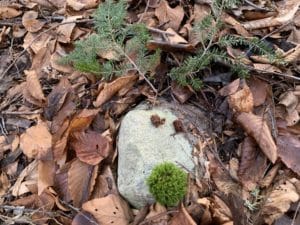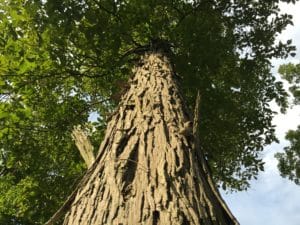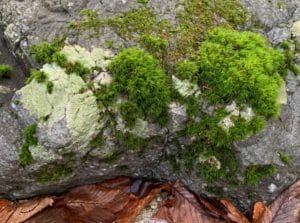Hello Fellow Readers, Indeed, winter can be dreary, especially without a frosting of snow. But it’s also a time to marvel over hidden treasures we don’t notice when the world is green, like statuesque trunks of Shagbark Hickory (Carya ovata) with their grey peeling trunks. And wispy white Paper Birch (Betula papyrifera) with dark cracks that can look like faces. Or the salmon-colored peeling bark of River Birch (B. nigra), more popular now as they are less prone to diseases and borers. Then, there’s magnificent moss.
Sculptures amongst nature
Speaking of faces, I often see sculptures amongst the riches of nature. Last week I came across a mossy rock. The velvety green swaths clinging on the rock looked like a hippopotamus. I snagged a photo and sent it to brother Rick who lives in Tennessee.
Rick has a stuffed hippo from childhood, thanks to a restoration long ago. The threadbare fellow once lived in a box with a t-shirt wrapped around his belly to keep the stuffing from falling out. Henry landed in the trash when Rick was heading off to college. I saved him from his fate, stitching a new bottom in fabric to complement his orange fur, then snuck him in Rick’s luggage so it would be a surprise.
“We see him! Turned this way,” Rick wrote back, sending a side-view picture of Henry the hippo.
About Magnificent Moss
Moss lives on various hosts but is not parasitic, meaning it doesn’t feed off them. Mats or clumps thrive on trees, rocks, and along the ground in shady, damp spots. Some species can tolerate full sun and months of dryness coming back to life in literally a day.
Moss (Bryophyta) is a nonvascular plant, which means it lacks transports systems such as xylems and phloems, which move water and nutrients from roots to stems and leaves. They are herbaceous plants (non-woody) absorbing nutrients and water by way of their leaves. They don’t have flowers or seeds and multiply by spores.
And they are ancient. Moss dates back to 251 to 299 million years ago, based on discovering fossils found in Antarctica and Russia. Likely they date back far longer, but because of their soft nature, older fossil remnants are not scientifically confirmed.
Carefree moss on green roofs and as a lawn alternative
Moss is used on green roofs because they require far less planting medium, and therefore less weight load on the roof compared to rooted plants. They can absorb as much as twenty times their weight in water yet also tolerate drought. And the fuzzy plant provides insulation.
Turf buffs consider moss a weed. Moss lovers consider it a carefree lawn alternative needing no mowing or fertilizing. And, moss is the mainstay in Asian gardens representing calmness. Green is proven to be emotionally soothing, releasing stress and encouraging healing. Being green is good; being adorable and fuzzy, a bonus.
Garden Dilemmas? AskMaryStone@gmail.com (and now on your favorite Podcast App.)
Links to previous columns you’ll enjoy: Beloved Birch and Juglone Companions (about Shagbark Hickory and Black Walnut)
You’ll get a chuckle out of a podcast titled Beauty in Dreariness & Furry Invaders (link below).
 On Christmas Day, I came across a mossy nose rock and antlers made of hemlock twigs. I couldn’t help but add eyes by placing tiny pinecones in position. Call me a Big kid :^)
On Christmas Day, I came across a mossy nose rock and antlers made of hemlock twigs. I couldn’t help but add eyes by placing tiny pinecones in position. Call me a Big kid :^)
Column updated 7/4/21





